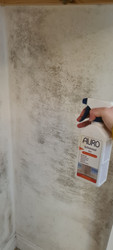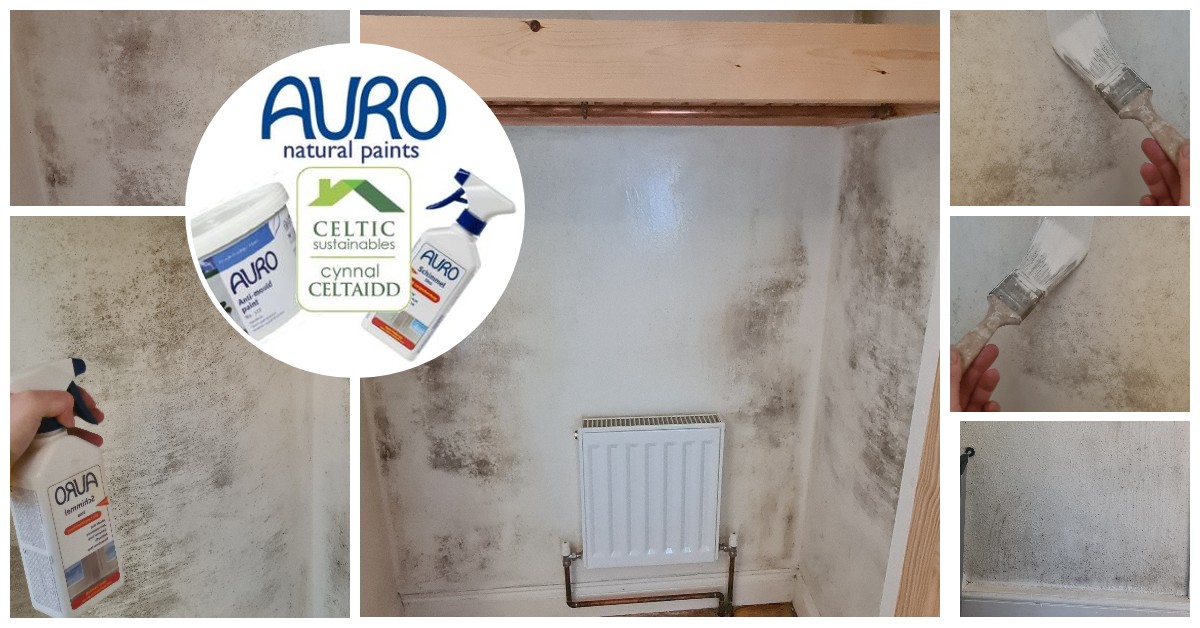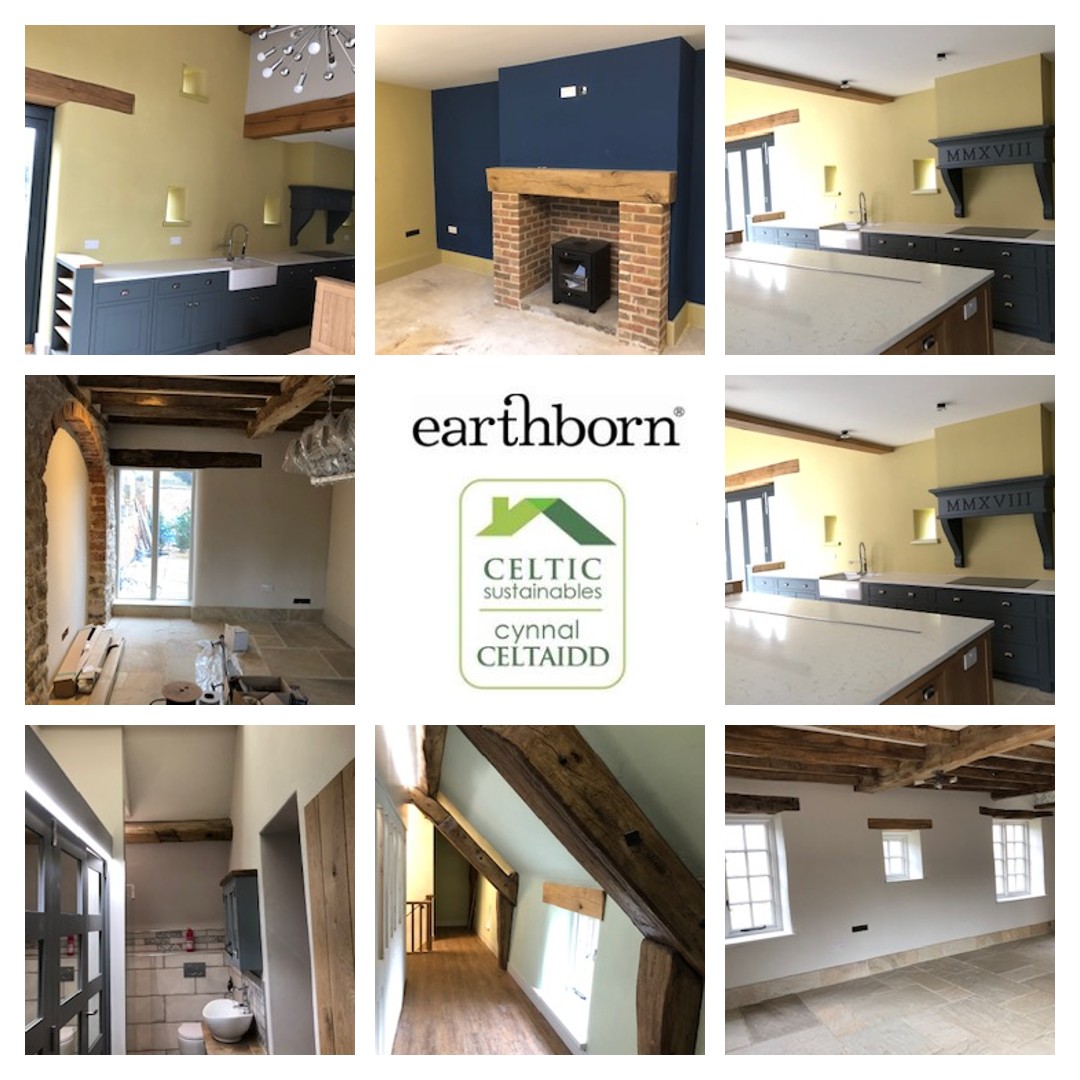Treating Mouldy Interior Walls with Auro
Posted by Sarah, Celtic Sustainables on 11th May 2022
Sarah, who has worked at Celtic Sustainables since 2017, has become familiar with the different finishes that Celtic Sustainables supply and the different benefits of using them. When she purchased her first home in 2019 she was thrilled to start putting some of that knowledge to good use!
A house that is nearly 200 years old comes with plenty of character, and plenty of issues. Originally built with two rooms downstairs and two upstairs with a little ty bach twt (toilet) outside. The original part of the house was built with stone and finished with laths and lime plaster,the house then had a modern extension added to it in the 70’s and with it came cement, asbestos, and damp…oh the damp!
Sarah’s experience on treating mouldy interior walls
“We knew what we were purchasing when viewing the property and knew it would take many years to fully restore. With our budget and time, we decided to work on what we could to improve the health and condition of the building.”
A lot of our customers come to us at Celtic Sustainables with issues with damp in their homes and we try to work with them to help identify what the cause of the damp could be, before advising on best methods to eradicate the issue. With this in mind, my partner and I set out to tackle why we were getting mould in the first place!
Condensation is not the only cause of damp
We fixed our guttering which was blocked and broken in some parts. Leaking and damaged gutters are usually the cause of moisture ingress which will rot wood, effecting the foundations of your home. Once moisture finds its way inside, your plaster will blow and mould will start to grow – overall, it will compromise the buildings safety and it shouldn’t be a issue overlooked.
“‘Penetrating damp’ is caused by moisture coming into the house through leaking or cracked pipework, a damaged roof, blocked guttering, gaps around window frames and cracked or defective rendering and brickwork. All these problems can be remedied.” – Centre of Sustainable Energy
At the same time we fixed roof tiles. Not a very nice job, but another important one! A leak caused water marks on our upstairs ceilings another massive issue that shouldn’t be overlooked for too long.
Once we’d fixed those two external issues, we let the house dry out over summer and then repaired the plaster, finished with a breathable paint.
Ventilation helps prevent humid air from getting trapped indoors and wreaking havoc with mould growth. To prevent the mould from re-growing we improved air circulation, good airflow can help cut back on moisture and will dry wet areas of your home more quickly. With that in mind we installed a bathroom fan to help with humidity, opened windows on dry mornings, and kept the heating in each room steady and equal to other parts of the house.
A moisture meter is another important instrument used in many industries to detect moisture pockets which might cause mould growth. We installed an ETI comfort thermometer, this is helping us to regulate the humidity in our home. A moisture meter can’t detect mould growth but can detect high humidity levels which are breeding grounds for mould spores. The colour-coded comfort bar gives a quick indication of whether the room is too cold, comfortable, or too hot.
In the winter we really struggle with condensation on our old wooden window frames and the surrounds which get mouldy. We purchased a dehumidifier, which has been one of the best investments we’ve ever made. It’s a great way to solve condensation, damp and mould problems. Winter is prime time for mould infestations to intensify as we tend to keep windows and doors closed to keep out the elements and to keep the heat in. In doing so, your home lacks proper ventilation, which causes the build-up of humid air. As the months roll by, condensation gathers making for perfect damp conditions for mould to form. We used to open the windows up a crack and use multiple towels to dry the windows, now the dehumidifier sorts that all out for us, very clean and simple.
This is what the Energy Saving Trust had to say about cutting the risk of condensation build up:
On average, a family of four will create more than 100 pints of moisture each week – and if there’s nowhere for it to escape, it’s going to build up on surfaces.
- Reduce the moisture you create, try keeping lids on pans and avoid drying clothes indoors.
- Increase ventilation: always use extractor fans in the kitchen and bathroom, avoid blocking wall vents, and keep window vents open if you have them.
- Try to maintain a constant temperature: rooms where the heating is turned off over the winter months are prone to damp problems. In this case, you may need to ventilate more, or turn the heating on from time to time
Auro Anti Mould System for Interior Walls
The final stage for the war on mould, was to clean down any mouldy walls and finish with the Auro anti mould system (products sold separately).
We first sprayed down the walls with Auro 412 Natural Mould Remover it’s excellent to get rid of mould on walls, tiles, plastic, and wood inside (for example on bathroom walls and ceilings, above showers and around windows). It is absolutely necessary if you’re looking for the first step to permanent eco-friendly mould removal from your home. We sprayed the surfaces uniformly and allowed some time to pass before we took a soft sponge to the walls to remove the dissolved residue. I was totally surprised how easily the mouldy spores came off, we wiped thoroughly with a clean sponge to make sure all the dirt and spores where washed away.
We then did a subsequent treatment with Auro 413 Natural Mould stop . The ideal follow-up product for the mould eliminator. It’s a chlorine free, eco-friendly product that is a great non-caustic way to stop black mould growth long term (doesn’t get rid of staining) This is also a great preventative treatment product against black mould as well. You can use it in your bathrooms and on windows to make sure those areas will not grow mould. Also if there are any areas of your house that receive little to no ventilation and are particularly stuffy, you can certainly use this as a preventative measure against the threat of those humid areas.
This product is perfectly suitable to use on wood and tiles which is great for all areas of your home.
Once the walls had been sprayed with the eliminator, we let it dry and then we used the remaining product in the system, the anti mould paint auro 327 . It's compatible with the eliminator and mould stop, it’s a natural mould resistant paint for interior walls and ceilings. It’s virtually VOC free, solvent free, lime based and breathable, all-important factors as we where also painting the spare room, the main bedroom and the living room, all spaces occupied by people and pets. We gave the paint a good mix and applied with a paint brush, little to no smell as we applied it. We kept the windows open to ventilate the room as we worked. We needed cardboard down on the floor, as it is more ‘drippy’ than thicker emulsion paints. We used it on the back of a built-in wardrobe, the hallway opposite the bathroom, condensation had really settled on this wall and mould was starting to creep down the hallway and finally finished off with two coats of paint in our living room.
Overall, were very happy with the finish, it’s a whiter finish than previous emulsion paints we have used, it has really worked to brighten up the rooms and it’s such a pleasure to see the walls with NO mould. I’m really looking forward to the next winter in our home now that we have made all these changes to improve air flow, ventilation, and resolved the issue with condensation.
Insulation can help too ...
Insulation is one of the most powerful tools for mould prevention as it helps to keep the room warmer. Condensation is less likely to build up on a warm surface, so insulating a whole property reduces risk. If you have the space, interior walls can also be insulated using Warmshell Woodfibre Insulation Boards.
At Celtic Sustainables we also offer a range of natural insulation systems, such as sheep’s wool and hemp, which can help regulate humidity in your home.





